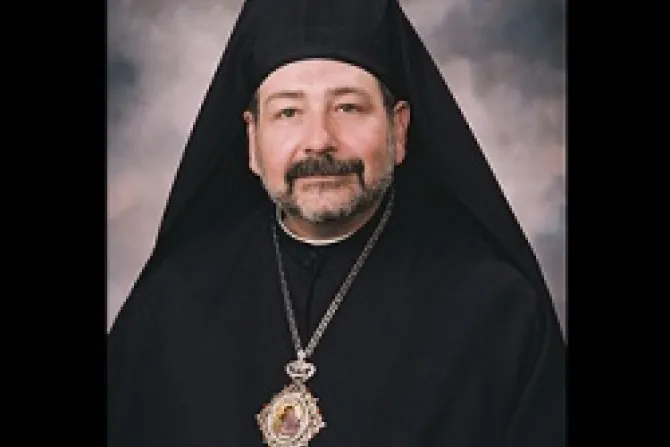Columbus, Ohio, May 7, 2013 / 01:04 am
The bishop of the Eparchy of Saint George in Canton is thankful that the area now extends across both Canada and the U.S., enabling him to serve all Romanian Catholics in North America.
On April 23, Pope Francis extended the eparchy's jurisdiction, which was throughout the U.S., to cover all of Canada as well. The eparchy – which is equivalent to a diocese in the Latin Church – had already, in 2010, been given jurisdiction over the two existing Romanian Catholic parishes in Canada.
"That's where the problem lay, it was kind of unclear what we'd be able to do throughout the rest of the country, in terms of establishing new missions, or taking care of dispensations, permissions and marriages," Bishop John Michael Botean, told CNA May 2.
"So this is a clarification we needed, and which I'm glad the Holy Father granted."
The Romanian Catholic Church is a Byzantine-rite Church in full communion with Rome and which is headed by the Major Archbishop of Fagaras and Alba Iulia, Cardinal Lucian Muresan.
Bishop Botean explained that the eparchy's extension is important because of the increasing Romanian presence in Canada.
"There is more immigration of Romanians to Canada than to the U.S., and we've been approached by Canadians in a couple different areas...to explore the possibility of establishing missions."
The eparchy has received requests for missions by Romanian communities in British Columbia, Alberta, and Ontario. But without jurisdiction throughout Canada, it had been unable to fulfill these requests.
"I hope we'll be able to look into that more seriously at this point now," Bishop Botean said.
"The fact that our mission now involves our neighbors in Canada, people who actually...already have relationships across the border, that just extends our family in a way that can't but be beneficial to us."
The eparchy faces changes in the U.S., because its 21 parishes and missions are located primarily where the economy was doing well at the beginning of the 20th century, where Romanian emigrants settled, which is "not necessarily the case anymore in any of those places."
Parishes of the eparchy are now either focusing on "mission" and reaching out to their neighborhoods, Bishop Botean said, or they "find themselves in trouble, as Romanian families move away from the area...mission becomes important."
The eparchy's extension had been requested by the Romanian Catholic synod and Cardinal Muresan, who forwarded the petition to the Congregation for the Oriental Churches.
The Romanian Catholic Church is in the Byzantine-tradition, and so uses the Liturgy of St. John Chrysostom, like the Melkite, Ruthenian, and Ukrainian Catholic Churches. It is constituted by five eparchies in Romania as well as the Eparchy of St. George in Canton.
The parishes of St. George's eparchy use Romanian or English, depending on whether their communities are long-established or composed primarily of recent immigrants.
"But usually we try to hang onto at least a little Romanian here and there in the liturgy to remain close to our roots, even where we use English," Bishop Botean explained.
The Romanian Catholic Church was established in 1698, when an Orthodox bishop in Romania entered union with the Bishop of Rome. This decision was confirmed by a synod in 1700, and was done to protect the civil rights of Romanians, who were being oppressed by the ruling Hapsburg Empire.
Bishop Botean explained that the union was also done "as a mean of preserving orthodoxy," as the ideas of Protestant theologian John Calvin were at the time spreading through the Orthodox churches in Romania.
In 1948, Romania's communist government forcibly dissolved the Romanian Catholic Church, and its properties were either seized by the state or given to the Romanian Orthodox Church. The Church existed underground until the fall of communism in Romania in 1989.
The Romanian Catholic Church is "a way of living the diversity that's inherent in the Church by way of God's gift, not by human decision," Bishop Botean said.
"The fact that the Church has taken shape in different ways...shows that the Gospel wants to take flesh where it is."
"We have a special role to play not only in manifesting the diversity of the Church, but also in being the bridge Church we're called to be, between Catholicism and Orthodoxy," he added, "but in a way that's consistent with the Second Vatican Council and by means of a recovery of our own tradition, by being truly and authentically self-governing...and still living the mission that was entrusted to the Church by Christ, as a part of the Catholic Church."
The mission of the Romanian Catholic Church is "not just a matter of trying to take care of our own folks," he said, but is "a matter of preaching the Gospel, loving your neighbor, and giving witness to Jesus Christ."
"And in the West that means to the un-evangelized, de-evangelized, and under-evangelized folks we live in the middle of. Our way of expressing and living Catholicism is a way that speaks to people even in the post-modern age. Not everyone certainly, but to a lot of folks."
St. George's eparchy also includes two monasteries, one of men and one of women. These communities live an authentic Byzantine monastic lifestyle, accessible to the faithful but not engaged in pastoral ministry or teaching. People seek out spiritual fathers or mothers at the monasteries, "who become the spiritual sources for the people. People go to the monasteries for confession, spiritual advice, spiritual direction, that's pretty much their main charism."
Bishop Botean concluded by saying he is "certainly grateful" for the extension of the eparchy.
"It's true it's more work, but we have...to become the spiritual force that God would want us to be, and that's my mission in this diocese, to transfer that sense of mission to our people as much as I can."



